adhesives with hot air is always recommended whenever you want to stick items over large surfaces or remove anything sticking to a large surface. When hot-melt gluing, hot air gives the glue a longer "open time", also ensuring good adhesion on large surfaces.
Activating
Adjusting
the position of bonded workpieces is a problem with hot-melt adhesives, particularly where large surfaces are involved. Hot air can significantly extend the "open time" of adhesives, making it possible to carry out precision adjustments.
Anti-drumming mats
not only let little children sleep in the back of the car, they are also a worthwhile investment for drivers who clock up high mileages. Particularly at low temperatures, the engine-noise deadening material is often hard or stiff, making it difficult to fit. Hot air makes anti-drumming mats pliant in next to no time. This way, they are easy to mould around bends and fit into corners.
Bending
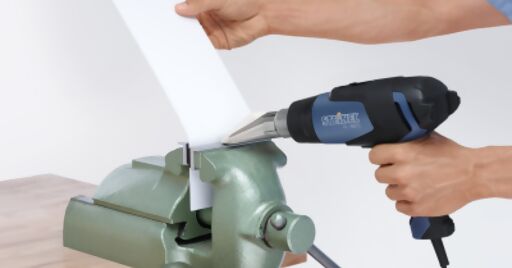
wood, plastic or copper can also be achieved with hot air. Particularly in model-making, it is often necessary to bend pieces of wood into a specific shape. To do this, the wood is soaked and bent in a wet state and, if necessary, clamped in place. It is then dried with hot air.
- Hot air makes plastic pipes or panels supple, enabling them to be shaped or moulded in any way.
- Copper can also be bent by steadily heating it. Please bear in mind that metal is a good heat conductor, so be careful not to burn yourself.
Bonded joints
can be loosened quickly and neatly with hot air. Whether you want to remove decorative foils from a door, edgeband from furniture or take up PVC flooring, the hot air tool fitted with a surface nozzle helps you to finish the job in next to no time!
Bumpers
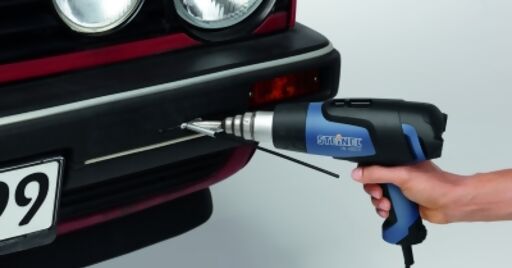
and spoilers are in most cases made of plastic. Accident damage is quickly repaired with the hot air tool and, if needed, the appropriate welding rod. (see "Welding plastic")
Bundling cables

When it comes to cabling work, a hot air tool is perfect for bundling cables. Using a reflector nozzle to generate even heat is recommended here.
Burning off
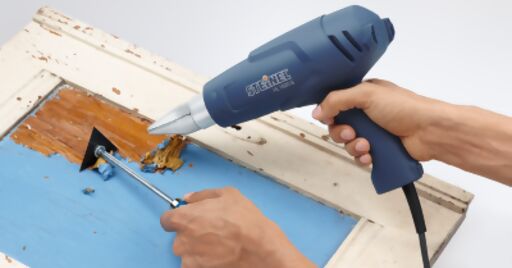
Old coats of paint and varnish has so far been a problem: naked flames are dangerous and can easily scorch wood or materials close by. Hot air now makes it easy to soften paint and thoroughly remove it with a paint spatula or paint scraper. Specially shaped scraper blades are available for corners and profiles (see accessories). Once the paint has been removed, you should rub the surface down with fine-grain sandpaper before applying a new coat. (see "Paint stripping")
Cable stripping
Hot air can be used to strip a cable. This can be done using a reflector nozzle.
Candle holders
can be cleaned of dribbled-down wax in next to no time.
Candle wax
can be quickly removed from tables, floorboards, tiles etc. with hot air. Be careful, however, to avoid overheating the surface any wax has dribbled onto!
Candles
quickly lose their shape or even break in two. In either case, hot air can help to make them look as good as new again. Crooked candles are placed on aluminium foil and heated. They can then be straightened without a problem. If candles break, you heat the surface where they have broken and join them back together again.
Car mastic
dries very slowly if it needs to be applied thickly. Hot air significantly speeds up the drying process. But be careful not to use hot air too intensely or the filler paste will dry too quickly, possibly resulting in surface cracking.
Car mats
are collectors of road dirt, which means they frequently need thoroughly cleaning with water. When drying them afterwards, the hot air tool quickly evaporates moisture in every last depression.
Car wrapping
Generously cut to shape, lay the film sections without base film onto the pre-cleaned car. Proceeding from the centre and working outwards, stick on and press down using squeegee and gloves. At a setting of 50 to 80°C, the film can be stretched and made to fit the shape. Using the HL Scan, temper at the temperature given for the particular film to retain its form. Finally, cut off and remove excess edge material.
Chemistry
The STEINEL hot air tools are specially designed to ensure that they stand upright without the need for any additional support. As a result, for example, this makes them ideal as Bunsen burners in the chemical industry, with infinitely variable temperature regulation providing optimum control the heating process.
Cleaning

- After heating with the hot air tool, burnt-on incrustations on barbecue griddles are easy to scrape off with a scraper.
- Glass fronts on wood burners are also far easier to clean after treating them with hot air.
Clinker facing bricks
made of thermoplastic material are popular for cladding building exteriors and interior walls. Just a few millimetres thick, the facing bricks are stuck to the base surface and simply bent round corners and edges. To prevent clinker facing bricks from breaking when bending or shaping them, heating them with hot air first is recommended. Cracks or fractures in clinker facing bricks can be patched up again with hot air.
De-waxing
- also see ➛ Candle holders ➛ Candle wax
Defrosting
chest freezers and freezer cabinets is achieved particularly quickly with hot air. But make sure that the hot air used does not deform the plastic material in the interior.
Desoldering
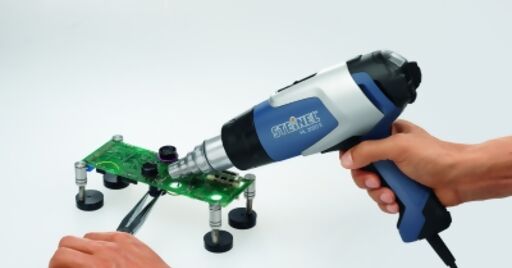
Electronic components can be de-soldered from printed circuit boards at approximately 400°C. This is done by heating the soldered connection and detaching the component with the special tool once the solder has melted. Caution: high temperatures will irreparably damage semi-conductors! Copper pipes are heated via a reduction nozzle to 600°C at the soldered joint. Loosen with a pipe wrench after approximately 90 seconds. Do not touch: You could burn yourself!
Disinfecting
potting soil, bird cages and other pet hutches can be achieved easily, reliably and non-toxically with hot air. Most bacteria and pathogens are killed off at around 500°C. Wood ticks and woodworm do not stand a chance at these temperatures either. Make sure you allow for sufficient clearance from combustible and heat-sensitive materials.
Drying
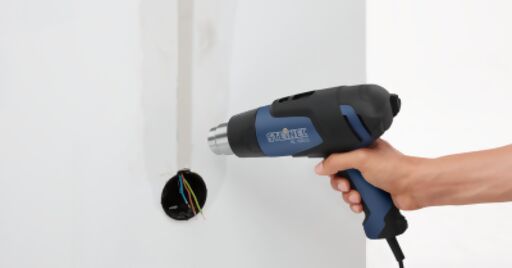
is, of course, a particular strength of hot air tools. Colour samples dried with hot air enable an objective assessment after a very short time. Joints in building construction must always be dry before injecting insulating and sealing materials. Not a problem with hot air! Hot air can be used for drying stucco work, making it possible to remove the moulds sooner. After grouting tiles in the bathroom, toilet or kitchen, the drying process can be sped up significantly with hot air. Planked wooden boats are often left with moisture in joints and cracks which can be dried with hot air before painting or varnishing. Quickly dried with hot air, many adhesives (➛ Open time) reach their final bond strength after just a short time.
Drying thoroughly

Drying or setting pastes, paints, fillers etc. can be sped up by blowing them with hot air. To do this, select a minimum temperature setting (approx. 50°C) and maximum airflow rate. As solvents evaporate more quickly when exposed to warm air, you should take particular care when doing so and ensure good ventilation (open windows or work outdoors).
Edgebands

from DIY stores are in most cases backed with a coating of hot-melt adhesive. They are easy to apply with the hot air tool and pressure roller. This conceals unsightly edges on tables, doors, cabinets and shelves in next to no time.
Enamelling
Copper shapes and vessels can be turned into ornamental objects with enamel powder and hot air. This is done by heating the substrate material with the hot air tool and then sprinkling the enamel powder over it. Systematically targeting the flow of hot air ensures good colouration.
Exposed to hot air, untreated timbers take on a rustic colour shade.
made of polystyrene or acrylic is frequently used for shower partitions, banisters, greenhouses, furniture, and decorative objects etc. These are made from a thermoplastic material that is easy to shape and trim when heated. Using a hot air tool fitted with a surface nozzle, both sides of the workpiece are evenly heated for 20 to 40 seconds. They can then be bent easily over the edge of a table or similar surface.
Fitting
Hot air can be used to give plastic-shell type function shoes an ergonomic fit. For example, the hot air tool can be used to make final corrections to custom-fit inline skating boots with special-purpose pincers. In a similar way, hot air can be used to relieve discomfort caused by pressure points in plastic shoes or to make inlays fit properly. Use of the surface nozzle provides the answer in most cases. The temperature setting should not be too high (about 200 to 400°C), as shoes are often made of a combination of materials, some of which are less resistant to heat.
Floor tiles
- Joints and seams can be welded with a soft PVC welding rod (accessory). For this, use a welding nozzle.
Fossils
are to be found virtually every time you go out climbing or hiking. After careful cleaning, these ambassadors from a long-gone age are dried quickly and gently with hot air.
Glazing work
- When it comes to fitting new panes of glass, the hot air tool is perfect for quickly drying moist window frames. This is the only way of ensuring that putty finds good adhesion in the rebate.
Gluing
Hot-melt glue is one of the most commonly used adhesives. Unfortunately, it comes with problems when applied on large surfaces, because it cools down while it is being applied and looses adhesion. If you keep the glue fluid with hot air, you can extend its open time to almost any length in a way that lets you apply it to large surfaces and make adjustments without having to worry that it will set.
HT pipes
used for roof guttering or drains are often difficult separate. This is where hot air can help: heating the connections softens the severely hardened lubricating paste, making it easy to pull the pipes apart.
Heat-shrinkable tubes
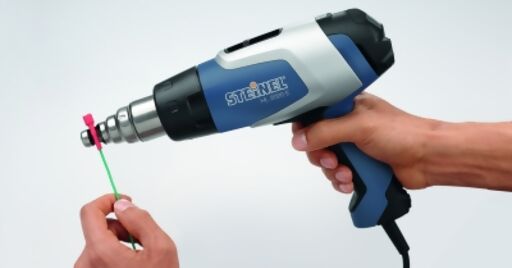
are polyolefin-crosslinked sections of tubing that shrink to 50% of their diameter when heated. They are used for insulating and marking cables in electrical engineering and electronics. (Repairing cables , Soldering sleeve)
Heat-shrinking
- When bottling wine, the plastic cap is placed over the cork and shrunk on with a hot air tool to hug the bottle neck.
- With scull oars in rowing, sleeves are particularly easy to shrink on with hot air.
Heating
Many materials are easier to shape in a warm state than they are when they are cold. For instance, the hot air tool quickly heats shoe inlays to make them provide an exact fit that perfectly matches the shape of the foot or shoe.
Heating rubber

The elasticity of rubber increases with temperature. For instance, a loose rubber grip on a bicycle handlebar can be heated with a hot air tool and returned to its correct position with effortless ease.
Hot polishing
is the easiest way of waxing rustic furniture. Hot air turns the wax to liquid so that it rubs into the pores quickly and evenly.
Hot-air barbecuing

is a healthy alternative to barbecuing with charcoal. To do this, a griddle is suspended in the middle of an old lidded saucepan or metal box. Below the griddle, the barbecue is fitted with an opening to admit the hot air. With the lid almost completely closed, hot air at approx. 600°C is then blown in through this opening. After just a few minutes even the thickest of steaks is ready to eat. And for the breakfast table at the weekend, rolls (slightly moistened) can also be heated and crisped up in this way.
Ignition systems
are often so damp in wet weather that the ignition spark cannot arc over. In this case, it helps to open the distributor and blow it dry with hot air.
Industry
Hot air tools also have a wide range of applications in industry. Designed specifically for rugged, continuous use, the professional hot air tools from STEINEL do an excellent job when it comes to drying, pre-heating and liquefying.
Inline skates
should fit well and not pinch so that skating remains a pleasure even over long distances. This is why many sports shops use a hot air tool to mould skates to fit a person's individual foot contours by heating the skate's ankle section and shaping it with special-purpose pincers for a perfect and comfortable fit.
Instruments
from veterinary medicine, for example, can be quickly heated and sterilised on location with hot air (600°C) for treating animal claws. Proceeding cautiously, hot air can also be used for treating claw and hood infections without harming the animal.
Lighting barbecues

No more chemicals! Leaving food to taste more authentic, charcoal barbecues can be lit faster and more healthily with hot air. The hot air tool becomes a turbo barbecue lighter and quickly gets the charcoal glowing for a perfect barbecue. Barbecuing has never been more fun!
Liquefying
tin, tar, bitumen and wax is not a problem with the hot air tool. The best way to do this is to stand the tool upright in the same way as a Bunsen burner and heat the material in a container placed over it.
- Liquid tin may, for example, be used at New Year for telling fortunes by pouring it into water and interpreting shapes, a tradition in Nordic countries (Molybdomancy, tin/lead pouring).
- Liquid tar can be used for filling gaps between slabs.
- Heated sealing wax is used for sealing parcels sent through the post.
- Beeswax can be liquefied with hot air, making it easier to remove from the honeycomb.
Meringues
A hot air tool can also be used in the kitchen. Hot air makes the meringue mixture crisp, leaving it with its typical browned surface.
Model-makers
use hot air tools for bending wood or for covering wings on model aircraft.
Modelling
With a hot air tool, there are no limits to your creativity! For instance, you can shape thermoplastics (polystyrene, acrylic glass) into interesting objects by laying them over any item and heating them with hot air. Unusual candles can be modelled or poured by working the wax with hot air.
Moisture
often leads to machine and equipment malfunction. Damp spark plugs and moisture in the engine's electronics are often the reason for engines being difficult to start. With a powerful blast of warm air from the hot air tool, the car or motorbike soon starts again.
Molybdomancy, tin/lead casting
is not only a favourite past-time for telling fortunes at New Year. Pouring tin is also a creative activity for collectors of tin figures. To liquefy the tin, the hot air tool is used standing in the upright position as with a Bunsen burner (➛ Liquefying).
Nozzles
enable you to direct the flow of hot air in the best way possible. This means that in order to achieve perfect work results, it is essential to select the right nozzle. Reduction nozzles concentrate the heat on small areas, surface nozzles spread it out. Reflector nozzles provide an even spread of heat, such as around pipes, or keep heat from sensitive materials (window nozzle). The welding nozzle is used for welding plastic.
Old oil and solvent-based paints and varnishes on wooden surfaces can be softened at 500 to 650°C with a surface nozzle and immediately scraped off with a stripping knife or paint scraper. On heat-sensitive materials, such as window glass, please use a window nozzle (to deflect the flow of hot air). Lightly sand the wood before re-coating.
should always be used it you want to remove old coats of paint or varnish using heat. Exchangeable profiled blades thoroughly remove coats of paint or varnish from any corner or edge. Extra-long scrapers or knife handles from the STEINEL range of hot-air accessories protect hands from being burned. The steel used for the blades is specially hardened.
Open fireplaces
can be quickly lit with hot air, requiring no other aids. The flow of hot air quickly gets the fire burning all of the fuel and, within a very short time, you have a cosy, crackling open fire.
Open time
is the time taken for hardening materials to set, such as adhesives. Given the nature of hot-melt adhesives, the open time is to a large extent governed by the temperature of the glue, meaning that the hot air tool can be used to extend it by almost any length of time (Adjusting, Gluing). With other adhesives, the open time depends on the evaporation of solvents or water (water-soluble substances), meaning that the hot air tool can be used here to shorten the open time (Drying).
PVC
can be shaped and welded with hot air (see "Shaping"). When welding with a plastic welding rod, it is important to distinguish between rigid and soft PVC.
Paint stripping

Old oil and solvent-based paints and varnishes on wooden surfaces can be softened at 500 to 650°C with a surface nozzle and immediately scraped off with a stripping knife or paint scraper. On heat-sensitive materials, such as window glass, please use a window nozzle (to deflect the flow of hot air). Lightly sand the wood before re-coating.
Painting work
Hot air makes many areas of painting work much easier and also gets it done faster. In particular, thermal paint stripping and drying, e.g. colour samples, make the hot air tool indispensable in this trade.
Perspex

(acrylic glass) is a popular material for modern furniture, displays and accessories. Cut to shape, the sheets are heated with hot air and can be moulded in any chosen way. (Synthetic glass, thermoplastics)
Plastic handrails
on stair banisters can be heated with hot air and then easily removed. To fit handrails, it is preferable to use a surface nozzle to warm the plastic material from below. A soft cloth is then used to press them on.
Plumbers and heating engineers
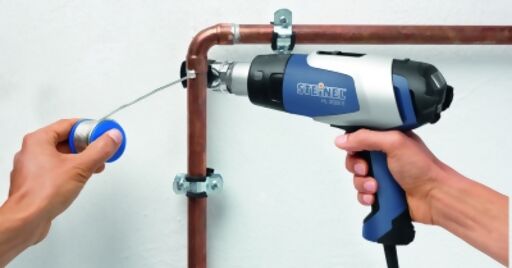
Plumbing and heating installations
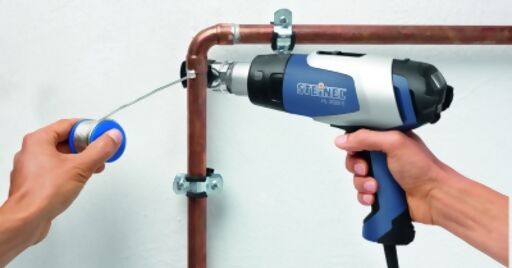
Hot air tools do a great job in the heating and plumbing sector. Besides soldering copper pipes ("Soldering"), they are extremely useful for making minor repairs.
- When laying PU pipes, hot air can be used for making stiff, cold pipes pliant for connections or for inserting into the circuits of underfloor heating systems.
Polishing
(rustic) furniture, doors and other wooden surfaces is done with wax and hot air. Heat softens the wax which can then be rubbed in very easily with a soft cloth.
Pond liners
Most wetland habitats in home gardens are created with pond liners that are available off the roll from any DIY shore. On site, the liner lengths need to be bonded or, better still, welded together with a hot air tool to create a liner of the appropriate size. (see "Welding tarpaulins")
Pre-heating
with hot air makes many work processes easier. When used oil is to be drained from an engine after it has been removed from the vehicle, it flows out faster and with better results after heating the engine block.
- Lawnmower engines are often hard to start if they are not used on a regular basis. Pre-heating with hot air soon has them going.
- When using hot-melt adhesive to glue materials that are good heat conductors, the temperature of the glue quickly falls, reducing its open time. Pre-heating the base surface with hot air can help to prevent it from cooling down prematurely.
- Bitumen panels for lining vehicle body parts can be pre-heated with hot air, making them easy to shape.
- Pre-heated with hot air, garden hoses are easy to fit onto connectors and taps.
Pressure rollers

are essential when welding certain types of plastics. The heavy pressure roller from the STEINEL range of accessories is ideal for edgebands and overlap welding plastic tarpaulins.
Quick drying
Quickly drying paint results in cracking. Although normally not wanted, it can also be attractive as a deliberate effect. Quick drying gives painted rustic furniture an antique look.
Reduction nozzles
concentrate the flow of hot air. Because reducing the diameter also results in a rise in temperature inside the hot air tool, reduction nozzles may only be used in conjunction with electronically regulated tools. These hot air tools are provided with a heat sensor that keeps the temperature constant – i.e. regulating it automatically. Besides concentrating airflow, reduction nozzles are also used as an adapter for other nozzles, such as slit nozzles and welding nozzles.
Reflector nozzles
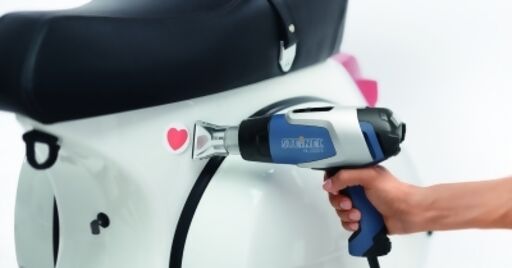
Whether car stickers, door liners, edgebands on cabinets or old PVC flooring: with a hot air tool and surface nozzle, stickers can be removed and adhesive joints loosened in next to no time. Using a hot air tool, film lettering (e.g. on vehicles) can be applied or removed with effortless ease.
Reflector nozzles
are ideal for ➛ Fitting heat-shrinkable tubes on cables or ➛ Soldering copper pipes. The reflector evenly spreads the air around the circular object. Soldering reflector nozzles are suitable for ➛ soldering sleeves.
Removing adhesive coatings
Hot air is the ideal helper for removing adhesive coatings, building materials etc.:
- Left-on floor coverings can be scraped off with effortless ease with a stripping knife once they have been heated with the hot air tool. Using a surface nozzle, direct the flow of hot air between detached floor covering and floor surface.
- Joint sealants are also easy to remove with hot air.
- See also ➛ Removing, ➛ Removing stickers, ➛ Candle wax and ➛ Synthetic renders.
Removing window-colour art work
window-colour art work without a trace is fast and easy with the hot air tool.
Repairing cables
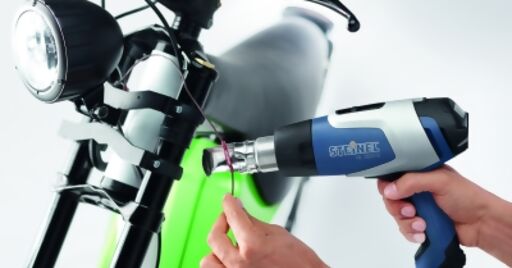
To protect cable ends, wiring harnesses, soldered connections or terminal blocks, simply slip the correctly sized heat-shrinkable tube over the section and heat-shrink it using a reflector nozzle (250 to 300°C). Crimp connectors can be used to secure electrical connections.
Resin bubbles
on panels or other timber surfaces can be heated with hot air and removed with a scraper or paper.
Reviving plastic

Plastic components on cars, for instance, lose their colour fastness as a result of weathering or exposure to chemicals in car washes. They can be revitalised using a hot air tool.
Roof repairs
on flat roofs are always on the agenda. Cracks and holes in standard roof/bituminised felt can be sealed quickly and reliably with bitumen compound and hot air. Bitumen sheeting can be stuck down well by overlap welding.
Ropes
made of nylon (e.g. z. B. halyards) tend to fray. This can be remedied by melting the ends with hot air. Unlike using a naked flame, this causes no discolouration at rope ends.
Screwed connections
are sometimes extremely difficult to undo because they are rusty or tightened very firmly. This is where hot-air treatment often works wonders.
Seasons
do not exist when it comes to using a hot air tool: stripping paint from windows in spring, lighting the barbecue in summer, stripping paint in autumn, de-icing locks and steps in winter etc. The list of potential applications is endless, whatever the season.
Shaping
- Carbon fibre orthoses / artificial limbs are custom-fitted by specialists using hot air.
- Thermoplastics can be shaped at relatively low temperatures (➛ Thermoplastics).
- Wood can easily be shaped permanently by soaking it first and then fixing it in place in the chosen shape until it has thoroughly dried (➛ Bending).
Shaping plastic
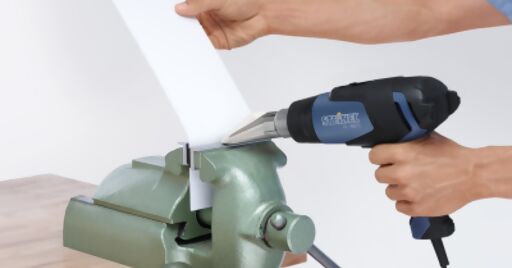
Hot air can be used to shape and mould tiles, pipes and rods made of plastic. Floor tiles are simply heated with a surface nozzle at approx. 200°C (plastic tiles: 250 to 500°C). Pipes or rods are heated all round with a reflector nozzle (250 to 400°C), shaped and fixed in place before they cool down. A coil or filling of sand prevents the pipe from kinking.
Shoe soles
made of rubber (e.g. crepe soles) can sometimes become detached from old shoes or from shoes worn in extreme weather conditions. They can easily be stuck back on again by heating the layers of rubber to melting point with the hot air tool and then firmly pressing them back on.
Shrink fits
- Following the same principle, shrink fits are also possible for connecting plastic pipes.
Shrink-wrapping
Packaging, parcels or small items can be provided with effective protection if they are wrapped in film. This is done using special plastic hoods or bags that are placed over the packaging and then shrink-fitted with hot air.
Ski repairs
Waxing and dewaxing skis, repairing plastic running surfaces and many other jobs are performed quickly and reliably with hot air.
Smoothing
Self-adhesive films, e.g. on book covers or PVC stickers, can be applied in next to no time with hot air for bubble-free results. If the film is made of rigid PVC, it can smoothed with a scraper or with a cloth.
Smoothing leather

When leather on furniture or in the car loses its shape, it can be smoothed very easily with a hot air tool. A temperature scanner should be used when working on leather to ensure that the workpiece is not overheated and that the optimum distance can be maintained.
Soft soldering

Soft soldering with hot air: clean the connection to be soldered and heat to approximately 300°C for 50 to 120 seconds. Feed in the solder and allow to melt without further hot air. When soldering without flux, coat the connection being soldered with soldering paste, soldering compound or soldering fluid. Once cooled down, remove with warm water (to avoid risk of corrosion). Use reduction nozzles for spot-soldering, reflector nozzles for pipes.
Soldered joints

can be loosened with hot air. The soldered joint is heated to melting point. A reflector nozzle should be used on pipes.
Soldering
cable lugs is made easy using a reduction nozzle. Just as it is to fit ➛ soldering sleeves.
Soldering roof gutters
is not a problem with the STEINEL powerful electronic hot air tools. Fitted with a reduction nozzle, the joint is heated to the point at which the solder melts on it. Remember: thoroughly clean and degrease the joint before soldering! (see "Soft soldering")
Soldering sleeves

and shrink-fit connectors are frequently used in electrical engineering for securely connecting cables. The soldering sleeve is a heat-shrinkable tube with solder inside which is pushed over the cable end. Heating with hot air solders the core or twisted cores and, at the same time, shrink-fits the plastic sleeve. With shrink-fit connectors, you first crimp the connection element integrated in the heat-shrinkable tube and then shrink-fit the tube with hot air.
Spectacles
Often need to be adjusted to fit the shape of a person's head. Conventional frame warmers are too small for large spectacle frames, resulting in uneven frame warming. This problem is quickly resolved with a hot air tool fitted with a reflector nozzle and used as a Bunsen burner.
- Spectacle arms can also be welded together again with hot air.
Sports equipment
Surfboards, plastic boats and similar objects can soon develop cracks and fractures if they are not treated with due care. Minor damage can easily be repaired with hot air. Where long cracks are involved, the damaged area should be filled with a welding rod of the appropriate material. (see "Welding plastic")
Staining
Exposed to hot air, untreated timbers take on a rustic colour shade.
Stripping cables
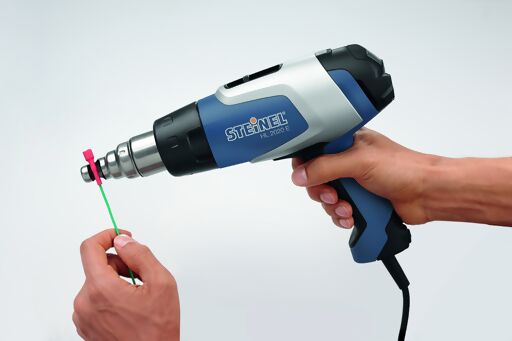
When disposing of cables or re-using them, they should be entirely stripped of the plastic sheathing. The easiest way to do this is to heat the sheathing with hot air. This makes it easy to remove with a stripping knife.
Synthetic render
on external and internal walls is usually only removed by chipping it off. This work can be done far more easily with the hot air tool. By heating it, the synthetic render can be softened and scraped off with a scraper in the same way as paint.
Tent tarpaulins
made of PVC sometimes tear if exposed to high stresses and strains or can be pierced as a result of carelessness. With a remnant piece of PVC and hot air, this type of damage can be repaired by overlap welding. (see "Welding tarpaulins")
Test tubes
are normally heated with a Bunsen burner. In practice, however, it has been shown that an upright standing hot air tool is in some cases better suited here (Chemistry).
Thawing
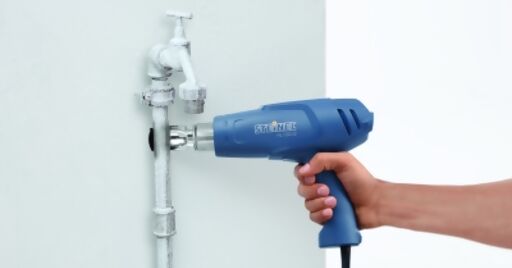
water pipes, icy steps or frozen car door locks is achieved quickly with hot air. The advantage: the material underneath the ice is not burnt, the water from the melted ice is evaporated by the hot air, preventing it from re-freezing again.
Tile cement
is stubborn and likes to stick to any surface. All the more annoying if this makes a tool unusable or if you want to re-use a tile you have salvaged. In both cases, the hot air tool lends a helping hand. The application of heat activates the adhesive, which can then be removed with a scraper and cloth.
Timepiece parts
in old grandfather clocks, pocket watches and wristwatches need to be cleaned from time to time. After leaving the cleaning bath, cogs, screws and springs are quickly dried with hot air.
Tools
are very often fouled up once the job is done. Stubborn adhesives and splashes of paint are easy to remove with hot air.
Trim mouldings
and rubber profiles protect car paint from scratches if anyone parking next to you is careless when getting out of the vehicle. Before adding these protectors, using a hot air tool to warm the points at which they are to be stuck on is recommended.
Two-component adhesives
reach a fast and higher final bond strength by heating them with hot air.
Underseal
Weathering and stone impact wreak havoc on car underseals, meaning that they have to be replaced or repaired every now and again. This involves removing loose sections or the entire underseal cleanly. Using a hot air tool, the underbody coating can be softened and scraped off. Always be careful to allow a sufficient distance from flammable wiring and pipe runs or rubber and PVC materials.
Vehicle bodies
The hot air tool is also an excellent helper when it comes to repairing vehicle bodywork: when repairing body panels with tin rod, you first heat the section you want to repair and then melt in the tin rod with hot air. When repairing glass-fibre mats, hot air quickly dries the filler compound.
Vehicle lettering
The hot air tool is a useful tool for applying as well as removing film inscriptions, e.g. on vehicles. Heating adhesive coatings ensures an excellent bond with the base surface. When stripping films, hot air softens the adhesive coating, making it possible to peel the film off without a problem.
Wallpaper
Thoroughly soaked, old wallpaper usually comes away from the wall fairly easily. There is always the odd patch, however, that remains firmly stuck to the wall. This is where hot air can quickly do the trick: in the hot, humid climate that is produced, even the most stubborn shreds of wallpaper come off with effortless ease.
Waxing
Weeds
Thoroughly soaked, old wallpaper usually comes away from the wall fairly easily. There is always the odd patch, however, that remains firmly stuck to the wall. This is where hot air can quickly do the trick: in the hot, humid climate that is produced, even the most stubborn shreds of wallpaper come off with effortless ease.
Welding nozzle
Working with plastic welding rods requires the use of this special accessory, which is pushed onto a 9 mm reduction nozzle. The welding nozzle consists of two ducts. The welding rod is fed through the small one, with the hot air flowing through the larger one. The welding nozzle not only has the function of guiding the welding rod straight to the workpiece but also of pre-heating it as it feeds through. When it emerges at the outlet, it has reached melting temperature in the same way as the workpiece below it. The welding nozzle can now moved along and pressed down lightly to produce a secure weld. (see "Welding plastic")
Welding plastic

Bumpers and all kinds of plastic parts can be welded extremely well with hot air: clamp the workpiece, clean the seam, degrease and, if necessary, chamfer. Then heat the weld with hot air (approx. 250 to 400°C) and feed in the appropriate welding rod using a welding nozzle. Note: the workpiece and welding rod must become "doughy".
Welding rods

made of plastic, welding cord or welding strip are used for welding rigid plastic materials. For a durable joint, it is always important for these welding additives to be of the same material as the workpieces being welded. (see "Welding plastic")
Welding sheeting
Ponds are balm for the soul and the environment. The most usual way of creating a pond is to dig a hole and line it with a pond membrane. Each liner section must be welded together to ensure a perfectly watertight join – not a problem with the hot air tool. The hot air is directed through a welding nozzle between the overlapping sheets of liner, with the softened strips of both sheets then being pressed firmly together with the pressure roller. (also see "Welding tarpaulins")
Welding tarpaulins

Welding plastic tarpaulins is not a problem with hot air: overlap and tension both tarpaulins. Using a wide-slit nozzle, blow hot air (300 to 400°C) between the two tarpaulins until the material softens. Slowly continue to move the tool and, at the same time, firmly press down the upper tarpaulin with the pressure roller. Test the welded seal by firmly pulling it apart. If stress-whitening occurs, the seal is okay. Otherwise, increase the temperature or roller pressure.
Wet sanding
is the order of they day for paintwork on cars, furniture and doors. Hot air can be used for quickly drying the workpiece so that painting can begin in next to no time.
Windows
are exposed to a particularly high level of wear. If the paint on window frames starts to crack or even flake off, it is time to strip them back to bare wood. The hot air tool is ideal for this job too. However, you should use a window nozzle to protect the glazing. This keeps the flow of hot air from the window pane.
Wings
on model aircraft are covered by experienced model-makers using hot air. This gives them a smooth skin for good flying performance.
Bitumen
is often used for repairing roofs in the form of bitumen roof felt or coating. This material rapidly turns into a liquid state with hot air, allowing it to quickly penetrate joints and cracks.



